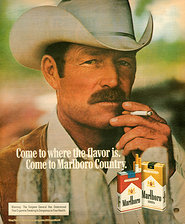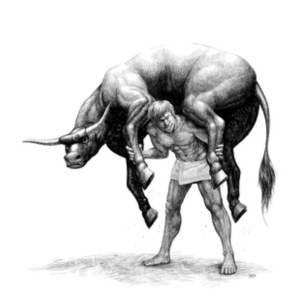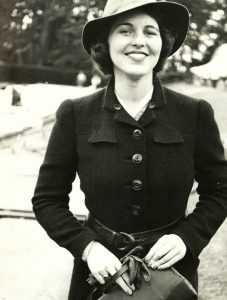“The Marlboro Man is dead” read the morning headline once again. Eric Lawson became the fourth “Marlboro man” in a row to die from a smoking-related disease. Aside from Lawson’s sad death, what made this international news? For two decades, the “Marlboro Woman” had been the marketing image for the filtered cigarette brand Marlboro for the Philip Morris Tobacco Company. That changed in the 1950s. Marlboro came to be associated with more than just “the flapper” of the 1920s, or the “classy lady” of the 1940s. Why limit the brand to women? By replacing the feminine imagery with masculine characters, men might start buying filtered cigarettes; but would they? Would they buy a cigarette that was made for women? In fact, they did, thanks to the new advertising campaign put together in the early 1950s, one of the most successful advertising campaigns in advertising history. This is the story of the Marlboro man.

Marlboro was a brand of filtered cigarettes created in 1924 targeting young women consumers. Marlboro cigarettes were marketed as being “safer” due to their filters; they were light cigarettes, “Mild as May,” sold in white boxes, and accompanied by a red cellulose around the filter to hide lipstick stains, which was very appealing to women. The idea of the Marlboro Woman began to crumble, though, when a report was published in the early 1950s, which prompted an initial 40 percent of Americans to agree that cigarettes were the leading cause of lung cancer. In the early 1950s, the Philip Morris Company, makers of Marlboro cigarettes, made the decision to change the image of their Marlboro brand and target a new market, young males, who were concerned about the dangers of smoking unfiltered cigarettes. Philip Morris and other cigarette manufacturers learned a valuable piece of information during the early 50s; male smoking was still popular, but the dangers of getting lung cancer from smoking led many to seeing filtered cigarettes as somewhat healthier than unfiltered. The sales of filtered cigarettes, like the Marlboro brand, increased, while cigarette brands that were unfiltered saw their sales falter. A new branding could have many advantages. Philip Morris already had a filtered cigarette, meaning that it was only a matter of repositioning the Marlboro brand to appeal to male customers. Not only did men start to buy these filtered cigarettes, but they did so not completely because of the perceived health benefit. They did so because they came to identify with the new branding images associated with it, namely the image of the Marlboro Man. The new packaging and toughness was also targeted to men, who wanted to protect their cigarettes in rough conditions, along with a flip-top that was designed for smokers to look at while taking out a cigarette. Its new and “improved” look was easily recognizable on TV screens, along with the “Marlboro” brand.1
Joining Philip Morris’s advertising team was Leo Burnett, a former newspaper reporter who had moved to Chicago to open his own advertising agency in 1935. This Chicago-based advertising agency was known for being able to target new audiences and craft ad campaigns that emphasized brand image, focusing on the highly visual qualities of products. While both the Leo Burnett Co. and Philip Morris gathered their thoughts, knowing that they wanted to shift their consumer focus to men, they came up with the idea of presenting the Marlboro brand, not as a health alternative to non-filtered brands, but as a cigarette especially made for rugged archetypal masculine characters. More specifically, they chose the cowboy character as the best and only vehicle for their campaign.2 They had the focus. Now they needed the man who would become the Marlboro Man.

The initial Marlboro Man is said to have been inspired by the Life Magazine’s publication of Leonard McCombe’s photo essay featuring Clarence Hailey Long. Long, the foreman of the JA Ranch, was catapulted to national attention in 1949, when McCombe’sseries of photographs on ranching in the American West were published. The Texas cowboy was the first model to appear in a Marlboro advertisement. Long would subsequently be followed by other “Marlboro Man” cowboys over the next decade, including Wayne McLaren, Dick Hammer, and Eric Lawson, along with Andy Armstrong who was the ad agency’s art supervisor. Later, there came others, like the director of sales promotion for Philip Morris, Robert Larking, and from the Leo Burnett ad agency, Lee Stanley and Owen Smith.
Quickly, this Marlboro rebranding became one of the most successful in tobacco advertising, indeed in all of advertising. Its impact on sales was immediate. Within a year, the Marlboro brand went from the bottom-tenth to the top-fourth position in the U.S market. By 1972, Marlboro was America’s most popular cigarette brand, a position it still holds to this day.3
Many now ask why this marketing plan worked so well? Why was it so powerful and why does it continue to be powerful in some markets to this day? Many researchers have found that the Marlboro man brings together at least three powerful psychological drives. The first is its use of archetypes. The cowboy from Marlboro Country is a “Warrior and Traveler,” a unique American vision of what a typical Explorer should look like.4 He is what represents a lone traveler, and what many audiences began to feel attracted to. They wanted to be like the Marlboro Man and experience the Marlboro Country. The second psychological drive is visual semiotics, which is the science that analyzes how a sign brings meaning to a reader or a viewer. From the perspective of the The Marlboro Man as a visual, the viewer sees a universal masculinity and values connected to rugged independence and egoism.5 Along with the drive of liberty, which is what most American white men, who were mostly from the middle-class in the 1950s, sought. Marlboro Country itself symbolized a natural and clean world that was not polluted by issues at the time. It was America’s heartland, overlooking large vistas of “America” along with its terrain, which attracted a wide range of audiences and captured Americans’ imagination.

The tough, self-sufficient and hardworking Marlboro Man was one of the most famous ad campaigns. One of the many commercials shows a man getting off a helicopter, arriving to “Marlboro Country.” The commercial is followed by narration by a man who states how there is “always Time for a Marlboro,” while the package image is featured, the men are lighting their cigarettes and enjoying the scenery, giving the viewers a taste of what it is to be like them and “go to where the flavor is.”
The role of advertising agencies were known to have set far-reaching advertising trends in the 1950’s, like establishing a cultural and economic environment at the time. The traditional media consisted of radio, newspapers, and magazines, which remained vital during the early years of the decade. But later, television became the turning point for many advertisers with national media plans. Throughout this decade, advertising expenditures increased to surprising levels. Advertising agency J. Walter Thompson Co., for example, saw its billings rise from $78 million in 1945 to $172 million in 1955, and by 1960, $260 million.6 This was the decade of rising demand for consumer products, such as clothing, automobiles, refrigerators, and other appliances. Marketers continued to offer the “new and improved” products to maintain that high consumer demand. Such marketing drew on a new science of advertising, as seen in motivational research, demographic targeting, and generational marketing. But one, if the most important, factor in influencing advertising in the 1950s was the growth of TV.

By 1951, live television network services reached the West Coast via microwave transmitters, which established coast to coast national coverage. At the time, television programs would typically promote the name of the sponsor but not the star; for example, “Hallmark Hall of Fame,” “Texaco Star Theater,” “Colgate Comedy Hour.” “Goodyear TV Playhouse” and “Kraft Television Theater” were just a few of the sponsors who were mentioned. Madison Avenue continued to raise profits from the dramatic increase in TV spending. By 1949, TV spending was $12.3 million; after two years it had grown to $128 million. By 1954, TV had become one of the leading media for advertising, while radio suffered losses, since their audiences moved to TV. By the end of 1960, televisions were owned by 90 percent of households.

During the post World War II period, from 1946 until 1964, the overall meaning of a cigarette in American life underwent a significant transformation. Social acceptability of cigarette smoking was reaching historical high points and the rates of consumption were increasing exponentially. During this time, smoking was “cool” and “glamorous.” Hollywood stars like James Dean and Humphrey Bogart were never seen without one. Screen beauties, such as Audrey Hepburn and Marlene Dietrich, made smoking look sophisticated and sensual. So much so that by the late 1950s, around half of the populations of industrialized nations smoked, because the product was cheap, legal, and socially acceptable.7
Some of Hollywood’s biggest names from the 1950’s were appearing in films with cigarettes. The promotion of cigarettes was seen as a sophisticated and healthy task, almost as if it was created for the acting profession. Cigarette makers have had a long history of getting placement of their product in Hollywood. Films such as Breakfast At Tiffany’s, which is a 1961 film that starred Audrey Hepburn and George Peppard, where Hepburn was constantly shown as a chic, long, black cigarette holder. Many other films portrayed the positive image of smoking, which was seen as an object with symbolism, and an instrument that showed power and class, and ultimately accepted by society.
The Marlboro advertising campaign, created by Leo Burnett Co. and Philip Morris Co., is said to be one of the most brilliant advertising campaigns of all time. They turned the product from the slogan “Mild as May” which targeted a feminine lifestyle, into something ruggedly masculine in a matter of months. There was a time when cigarettes were originally sold as expensive handmade luxury goods for the urban elite, but no matter how you may feel about the tobacco industry, one thing is undeniable: cigarette manufacturers employed the best marketers in the business in the 1950s, making this one of the first and best success stories in the history of branding, never allowing us to forget the Marlboro Man and what he declared, “Come to where the flavor is; come to Marlboro Country.”
- Cameron White, John L. Oliffe, and Joan L. Bottorff, “From the physician to the marlboro man: Masculinity, health, and Cigarette Advertising in America 1946–1964,” Men and Masculinities 15, no. 5 (December 2012): 527-531. ↵
- Columbia Electronic Encyclopedia, March 2017, s.v. “Leo Burnett.” ↵
- James L. Hamilton, “The Demand for Cigarettes: Advertising, the Health Scare, and the Cigarette Advertising Ban,” The Review of Economics and Statistics 54, no. 4 (1972): 401-404. ↵
- Ira Teinowitz, “Philip Morris USA rolls Marlboro Milds to national audience,” Advertising Age 71, no. 10 (June 2000): 5-7. ↵
- John P. Pierce, Elizabeth A. Gilpin, and Won S. Choi, “Sharing the blame: smoking experimentation and future smoking-attributable mortality due to Joe Camel and Marlboro advertising and promotions,” Tobacco Control no. 1 (1999): 34-37. ↵
- Stepháne Pincas and Marc Loiseau, History of advertising (Hong Kong: Los Angeles, 2008), 24-26. ↵
- Linda Kulman, Madison Avenue’s Marlboro Man (American Ingenuity, 2004), 76-82. ↵




66 comments
Maggie Trujillo
This was an interesting article to read because growing up, there were always cigarette commercials and advertisements everywhere. Unfortunately, the risks were never mentioned back then. One interesting fact that I didn’t know about was that there was a Marlboro woman! It is interesting to see how much things have changed when it comes to cigarette smoking and how they advertise. It is nonexistent now compared to how popular it was to smoke just a few years ago.
Iris Reyna
Good job on the article Josselyn, it was informative and educational and was put together nicely. It was interesting learning about the campaigning and marketing for Marlboro shaped the company. It was cool to see how they intended to widen their audience viewing by using a cowboy to bring in men to buy more cigarettes. It was interesting to learn about the Marlboro company because I knew nothing about cigarettes or any companies.
Griffin Palmer
It’s interesting to learn about the Marlboro business tactics and how they sold to American customers for both men and women. This article does great at explaining the Marlboro man importance as a figure for the company in order to cell cigarettes. Not only was the Marlboro man important but so was the Marlboro women because she was used as a way to help cigarettes to women as well.
Lyle Ballesteros
This was a really good article and very informative and descriptive in how it relayed the history of the Marlboro Man and how successful the advertising campaign was. I am suprosed about just switching the mascot from a woman to a man garnered a while new audience and how advertising to certain genders work so often. Maybe it is also a show of the misogyny of the times that doing what would be considered a simple switch between genders for the mascot made them millions of more dollars, and men now viewed the same product differently because it was a male cowboy on TV and not a flapper.
Victoria Castillo
Great article! I know briefly of the Marlboro brand due to family members, but never the history of how it became more known. It was interesting to learn that the companies first main consumers were women instead of men. It’s a little strange though that there was always a bit of an on-off relationship with cigarette/tobacco companies and consumers, yet people continue to buy them when they are branded as more appealing.
Sierra Christa
Great Article! This article was filled with many shocking facts that I did not know about such as cigarettes were targeting to women. I think the fact that Americans were truly influenced by the marking of this company and cigarettes in general is fascinating. I think the role of media and advertising in our society is very prevalent and this article does a great job in high in that.
Hunter Stiles
First off, Congrats on the publication of your article! It is clear that hard work was well represented here!
The article provides information on the Philip Morris Tobacco Company, a cigarette company. The first song I play is “The Marlboro Man is Dead,” in which they introduce the ladies. This article explores the marketing strategies used by the tobacco industry throughout its history. They discuss the first Marlboro guy. The manner they advertised during the Second World War was another. In any case, the material is helpful for anyone working in marketing and management.
Super Fantastic Job!
Hunter Stiles
Congratulations on the publication of your article! I was shocked to realize that cigarettes were made to target women, even though i liked the part where they made a red filter to hide lipstick stain. This piece has a lot of information. I’ve never read an article about Marlboro cigarettes or smoking. I believe that those People who suffer from smoking would benefit from reading this post. As is common knowledge, smoking is unhealthy and harms our bodies significantly. By the way, I thought it was funny how the Marlboro advertisements made smoking look pretty or feminine .The article shows how the advertisement had a great effect on people especially young men and women, not only that but it really made me laugh when i read about how they were thinking that the filters may reduce the danger that cigarettes cause , moreover, i am wondering what the reaction of people was when they found out that smoking kills a lot of people and consider as one of the main reasons for lung cancer. This was a great read!
Dylan Vargas
The article gives us an idea about the tobacco company named Philip Morris Tobacco Company. I start off with “The Marlboro Man is dead” in which they start talking about the Malboro women. It is an article about the history of the tobacco company and what marketing they did. For instance, they talk about the first Marlboro man. Also the way they marketed during the second world war. Anyways the article is good about marketing and management for the people in that field.
Laura Poole
Wow I had no idea about the target to women with cigarettes! This article is a great example of how marketing can be used with ill-intent. It blew me away when I read about the red filters to hide lipstick stains! This article brings good awareness that everything advertised to you is not always best for you. Companies don’t care about your health only about how much of their product they can sell.